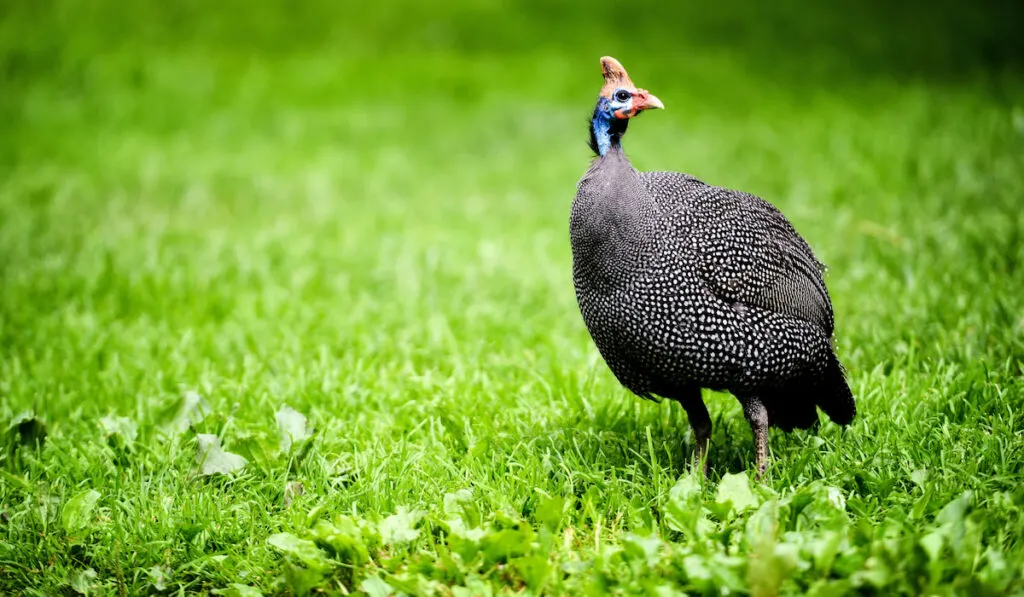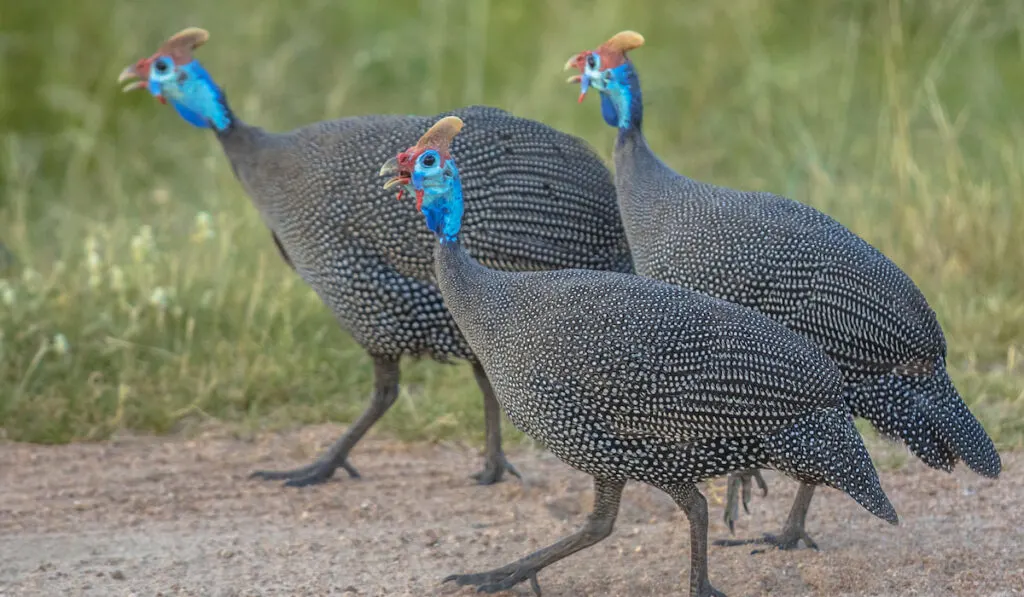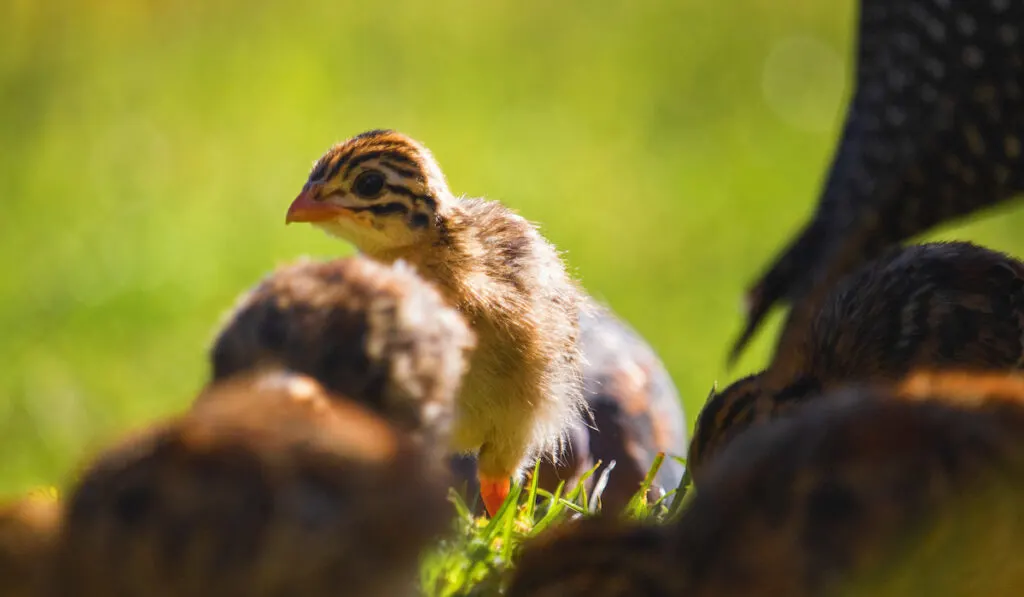Guinea fowl are beautiful birds that people use for various reasons. Many beginner homesteaders make the mistake of raising guinea keets just as they raise chicken chicks. What are guinea fowls and why should you raise them? Is there a specific way to raise guinea fowl?

Let us discuss the complete guide to raising guinea keets. In this article, you will know how to care for guinea fowl keets from hatching to living outside.
How do you raise guinea keets? Just like the young of every other bird, guinea keets need extra attention and care, especially in their first six weeks. Your guinea keets need:
- A brooder
- Source of heat
- Source of water
- Brooder bedding
- Coop or shelter to transfer into
Should you line the brooder? What kind of shelter should you construct for your guinea fowl? What can you do to prevent your free-range guinea fowl from flying away? You will have the answer to all these questions (and more) by reading this article.
Table of Contents
What are Guinea Fowl?
Guinea fowl, also called pearl hen, pintades, or gleanies, are birds that originate from arid regions of West Africa. The guinea fowl we raise today are domesticated from a wild guinea fowl known as the helmeted guinea fowl (Numida meleagris).
People raise guinea fowl for various reasons. The way you should raise your guinea fowl depends on why you are raising it. A few reasons why people raise guinea fowl are:

- Security: Guinea fowls are loud (the reason why many people do not like the birds) and can alert you when an intruder comes close to your home or farm
- Meat Production: People sometimes use guinea fowl meat to replace chicken meat in dishes. Guinea fowl meat has a stronger taste than chicken meat.
- Egg production: For at least 6 months of the year, guinea fowl lays eggs. Guinea hens can lay 25-30 eggs in her nest.
- Pest Control: Guinea fowl, when allowed to roam freely, eat animals such as insects, rodents, snakes, lizards, and earthworms. Guinea fowl even eat ticks that carry the Lyme disease-carrying deer ticks.
- Other Reasons: Whether you are a breeder or you are looking for a pet bird, you should consider raising guinea fowl.
Now that you have enough reasons to raise these lovely birds, how can you raise them?
The Step-By-Step Guide on Raising Guinea Keets from Hatching to Living Outside
If you stick with this guide, you will successfully raise guinea fowl from keets to adult birds.
What You Need to Raise Guinea Keets
You need the following items:
1. Guinea Fowl Eggs or Keets
How can you raise guinea fowl without having their eggs or keets? You can purchase guinea fowl eggs or keets from a local breeder, a feed store, or even order them online. If you like, you can collect and incubate new eggs from guinea fowl nests.
Note: The incubation period for guinea fowl is 26-28 days.
2. Brooder
A brooder is a box or container in which you raise young birds (in this case, guinea keets). The brooder size should be 16 inches by 28 inches for every 15 keets. A brooder can be made of cardboard, plastic, wood, etc.
You should line the brooder so that it becomes free from draft. The bedding of the brooder depends on the age of the keets. If the guinea keets are 0-2 weeks old, use a paper towel as the brooder bedding.
If you use wood shavings or sawdust as the bedding of the brooder at the young age of the keets, the guinea keets will eat the wood shaving or sawdust (you do not want that to happen).
Make sure that you change the paper towel daily. After 2-3 weeks, you can use wood shaving as the brooder bedding.
The brooder should have a constant heat source. You can use a heat lamp to provide sufficient heat for your keets.
3. Food and Water
What kind of feed should you give to guinea keets? You should ask feed shops if they have guinea fowl-specific feeds.
If, however, you cannot find feed made for guinea fowl, you can use feed made for chickens, turkey, or other wild game birds. Note that you should feed young keets with crumbles and not pellets.
How do you give water to your keets? Many homesteaders use nippled waterers for their keets. If you do not know how to teach your guinea keets to drink water from the nipples, use a water trough for chicks.
4. Coop or Shelter for When They Grow
When your keets have grown and are ready to be moved outside, they will need a shelter. If you do not want them to roam free, you should build or buy a coop for them.
The size of the coop should be 2-4 feet per bird. If you want your guinea fowl to roam free, you should provide a night shelter. Guinea fowl can roost in trees. If there is no tree, build a shelter for them.
Both the shelter and coop should have perches on which the guinea fowl can roost. The length of the perches should be 1 foot per bird. The shelter should have at least 2 doors so that dominant birds do not block other birds from going in or out of the shelter.

As a tip, you should install a cheap mirror in the coop because guinea fowl are very social and love to look at their reflection.
If you have gathered everything you need to raise guinea keets, it is time to raise your keets.
Raising Guinea Keets
Are you ready?
1. Introduce the Keets into Their New Home
Keets should live in their brooder for the first 6-8 weeks. When they are 0-2 weeks old, do not use wood shavings as the brooder bedding. You should set the height of the heat lamp to be 18-24 inches high.
If all your keets stay at the walls of the brooder (i.e. far away from the lamp), you should increase the height of the lamp. Likewise, if you see them all huddled together under the lamp, it should be lowered to provide more heat.
If you see a keet that is sluggish or slower than other keets, this is often a sign of being too cold. You should snuggle the keet in a warm blanket next to you for a few minutes before returning it to the brooder.
If the keet remains sluggish, it may be sick. Consider isolating the keet with it’s own heat, food and water sources. If the keet does not improve, you may need to consult a vet.
In no time, your keets will start jumping in the brooder. Make sure that you cover the top of the brooder with a screen.
2. Feeding Your Guinea Keets
You should feed the keets with guinea feed or feed made for other birds.
Guinea keets are fast-growing and very active birds, so they need a lot of proteins. When keets become adults, what you feed them and the way you feed them will depend on why you are raising them.
Below is a table of the protein requirement that should be present in the feed that you give to your guinea fowl:
| Guinea Fowl Age | Protein Requirement | Kind of Feed |
| Week 1 to Week 5 | 24-28% | Starter |
| Week 5 to Week 8 | 18-20% | Grower |
| Week 8 and Beyond (Penned) | 16-22% | Finisher or Layer |
| Week 8 and Beyond (Roaming Free) | 16-20% | Supplement |
As a general tip, you should use medicated feed. We will discuss more on feeding adult guinea fowl later.
2. Giving Water to Your Guinea Keets
You can choose between a normal chick water trough and nipples for your guinea keets. If you are using a normal water trough, put some pebbles in the trough. The pebbles will prevent the trough from falling and also prevent your keets from drowning.
In their first few days, you should place the beak of your guinea keets into the water so that they will learn how to drink water from it.
3. Caring for Your Guinea Keets
How do you care for your guinea keets? Here are a few suggestions:
- Change the brooder bedding regularly
- Replace their feed and water daily to prevent mold
- Use a paper towel to wipe dried poop of the feet of keets
- Hand-feed the keets sometimes so that they can bond with you
You should pay attention to the temperature of the brooder. In their first week, guinea fowl keets need a brooder temperature of 95°F. You should decrease the temperature of the brooder weekly (i.e. until you take them outside) by 5°F.
Are you worried that you are providing too much or not providing enough temperature? Use the guide below:
- Just the Right Amount of Temperature: If the temperature of the brooder is okay, your guinea keets will be evenly distributed in the brooder.
- Too Much Heat: If the heat is too much, the guinea keets will move towards the wall of the brooder. You will find very few or no keets in the middle of the brooder. You can solve this by taking the lamp a little bit higher.
- Not enough Heat: In a cold brooder, guinea keets will be sluggish and they will move closer to the source of the heat (i.e. the lamp). You can solve this by bringing the lamp a little bit lower or by adding another lamp.
Note: Guinea fowl are from the arid regions of West Africa. This means that they prefer a hot and dry place than a cold and humid place. Guinea keets can die because of cold or getting too wet.
4. Taking Your Guinea Fowl Outside
When your guinea keets are 6-8 weeks old (or when they have developed full feathers), you can take them outside. If you do not want them to roam free, you should keep them in a coop. You can also clip their wings.
If you want guinea fowl in the coop to lay eggs, you should provide nest boxes. Remember to install perches in the coop so that the birds can roost. Since they rely on you for feed and water, you should give them constant water and at least 1 pound of feed per 6 birds daily.
For birds that can roam, you should build a shelter where they can roost at night. They can also roost in a tree is it if present.
How do you keep free-range guinea fowl from flying? Follow the steps below:
- Keep them in the shelter for 2-3 weeks.
- While they are in the shelter, feed them regularly
- Give them millet and other grains when it is sundown for 2-3 weeks
- After 2-3 weeks, allow them to go out, but give them their sundown treats
- Make it a regular practice of giving them treats when they return to the shelter
- Make sure that the shelter is not dark, has perches and spacious enough for your guinea fowl
If you stick with the guide above, your guinea fowl will return to their shelter no matter where they go during the day.
5. Extra Care for Your Free-range Guinea Fowl
Who says that you should not care for guinea fowls that roam freely? Guinea fowl are happier if left to roam freely. Even though they will not grow quickly like cooped, intensively fed guinea fowl, they can also lay eggs and in time, they will be big enough for consumption (if you intend to eat them).
You should know that guinea fowl are monogamous, so when buying eggs or keets, buy a 1:1 male-female ratio. Also, when it is the season to lay eggs (the season is different from region to region, so you should ask a local farm extension office), they will dig nests in different locations.
If you see a male and female guinea fowl always together (and possibly around a nest), you should keep observing them until the hen lays eggs. To collect the eggs, wait till they both leave the nest in search of food. To encourage more egg production, do not collect all the eggs. You can collect half of the eggs at a time.
If some eggs hatch, do not leave the keets with their parents. You should care for the keets by yourself because:
- Guinea fowl are bad at parenting and can abandon their young
- Guinea keets can die due to the wetness of grass that they move through
If you do not have an incubator or you do not have time to brood the keets, you can employ a brooding hen or turkey to do the job.
There you go enjoy your guinea fowl!!!
Conclusion
Guinea fowl are loud but lovely birds that you can use for security, pest control, production of meat, and eggs. Do not expose your keets to high humidity and wetness. You should give regular treats to your free-range guinea fowl when to return to their shelter.
Do you love guinea fowls? When will you raise your first keets? Please do tell in the comment section below
Sources:
- https://pethelpful.com/farm-pets/Caring-for-Guinea-Keets
- https://poultry.extension.org/articles/poultry-management/raising-guinea-fowl-in-small-and-backyard-flocks/
- https://www.wikihow.com/Raise-Guinea-Fowl
- https://www.backyardchickencoops.com.au/blogs/learning-centre/6-essential-things-you-need-to-know-about-raising-guinea-fowl-keets
- https://en.wikipedia.org/wiki/Guineafowl

Paul
Saturday 2nd of October 2021
When would one consider keets to have grown nearly immune to snakes? My keets are nearly six and a half weeks old. I lost one to a snake some weeks ago, she eventually died from the snake bite. I try to let them out for a little while everyday into the coop. Then I locked them back up into a little tiny pen so that they're protected from snakes.
Greg
Thursday 23rd of March 2023
@Paul, thank GOD for GOD (Jesus)in your pen/shed have the floor laid with chicken wire to the corners of the coop/shed and fastened AND around the the perimeter And that may help. That's what I am going to do with our 2 meets that survived racing them out of six. Not knowing much until we looked up the raising of them.
billy
Sunday 20th of June 2021
hello great article and i have raised about 20 keets, that part was easy. then when they were 4 months old i put them outside and they were gone within a week, racoons got most of them. other than putting them in a aviary any ideas how to keep them from getting killed so fast?
Patricia Parker
Saturday 15th of May 2021
Thankyou for this information. I am fostering Guinea for my dad & daugher and was not sure if they could be raised similar to chickens. So Thankyou again.
Rhodes K Chinyoka
Sunday 4th of April 2021
Very informative indeed,however I want to know if a domesticated guinea hen that lays, incubates and hatches in a bush be able to guide the keets back to the house.
April Lee
Monday 12th of April 2021
If she is used to coming back to the house for feed then she would guide her keets back however, if she is able to find food, shelter and water in the bush she may stay out there with her keets and they would be much more wild. It is best to encourage her to come back near the house as soon as her keets hatch.